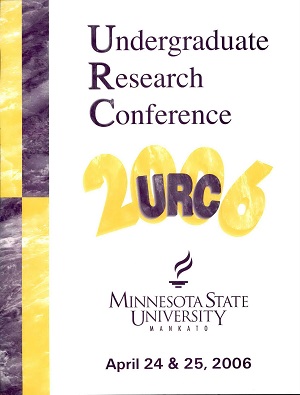The Effects of Drought and Temperature Stress on the Competitive Interactions of Smooth Brome (Bromus inermis Leyss.) and Little Bluestem (Schizachyrim scoparium Michx.)
Location
CSU North Ballroom
Start Date
24-4-2006 1:30 PM
End Date
24-4-2006 3:30 PM
Student's Major
Biological Sciences
Student's College
Science, Engineering and Technology
Mentor's Name
Christopher T. Ruhland
Mentor's Department
Biological Sciences
Mentor's College
Science, Engineering and Technology
Description
Invasive species are widely recognized globally for reducing biological diversity and threatening endangered and rare species. Bromus inermis (Smooth Brome) was introduced into the United States in the late 1800s to help alleviate erosion. In the past several years B. inermis has expanded its range creating monocultures that reduce overall diversity in the remaining tall grass prairie. In this study, we focused on physiological mechanisms responsible for competitive interactions between the invasive B. inermis and Andropogon gerardii (Big Bluestem; a native grass) under two different temperature regimes. Plants were grown intra- and interspecifically at 20 and 25" C for ten weeks in pots placed in environmental chambers. We examined leaf photosynthesis, transpiration, stomatal conductance and internal CO2 concentrations using an infrared gas analyzer. We also measured xylem water potential using a Scholander pressure bomb. Interspecific competition resulted in large reductions in the biomass of B. inermis than when grown intraspecifically at both 20 and 25° C. Transpiration rates of B. inermis were 42 and 24% higher than those of A. gerardii at 20 and 25° C, respectively. In addition, leaf water potential of B. inermis was 49% more negative than A. gerardii. We suspect that the increased competitive ability of A. gerardii results from a greater water use efficiency than B. inermis (based upon transpiration, photosynthesis and stomatal conductance measurements). Our results suggest that future increases in air temperature may alter the competitive balance between these two species, however uncertainties regarding future changes in precipitation may overshadow these temperature effects.
The Effects of Drought and Temperature Stress on the Competitive Interactions of Smooth Brome (Bromus inermis Leyss.) and Little Bluestem (Schizachyrim scoparium Michx.)
CSU North Ballroom
Invasive species are widely recognized globally for reducing biological diversity and threatening endangered and rare species. Bromus inermis (Smooth Brome) was introduced into the United States in the late 1800s to help alleviate erosion. In the past several years B. inermis has expanded its range creating monocultures that reduce overall diversity in the remaining tall grass prairie. In this study, we focused on physiological mechanisms responsible for competitive interactions between the invasive B. inermis and Andropogon gerardii (Big Bluestem; a native grass) under two different temperature regimes. Plants were grown intra- and interspecifically at 20 and 25" C for ten weeks in pots placed in environmental chambers. We examined leaf photosynthesis, transpiration, stomatal conductance and internal CO2 concentrations using an infrared gas analyzer. We also measured xylem water potential using a Scholander pressure bomb. Interspecific competition resulted in large reductions in the biomass of B. inermis than when grown intraspecifically at both 20 and 25° C. Transpiration rates of B. inermis were 42 and 24% higher than those of A. gerardii at 20 and 25° C, respectively. In addition, leaf water potential of B. inermis was 49% more negative than A. gerardii. We suspect that the increased competitive ability of A. gerardii results from a greater water use efficiency than B. inermis (based upon transpiration, photosynthesis and stomatal conductance measurements). Our results suggest that future increases in air temperature may alter the competitive balance between these two species, however uncertainties regarding future changes in precipitation may overshadow these temperature effects.
Recommended Citation
Kniffen, Christopher D.. "The Effects of Drought and Temperature Stress on the Competitive Interactions of Smooth Brome (Bromus inermis Leyss.) and Little Bluestem (Schizachyrim scoparium Michx.)." Undergraduate Research Symposium, Mankato, MN, April 24, 2006.
https://cornerstone.lib.mnsu.edu/urs/2006/poster-session-B/2



